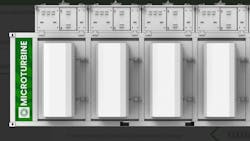Why Smart Buildings Are Turning to Microturbines for Grid Resilience
Key Highlights
- Microturbines provide reliable backup power, reducing vulnerability during grid outages and supporting safety and business continuity.
- They help lower energy costs through efficient heat and electricity generation, aligning with sustainability and cost-saving goals.
- Design innovations allow microturbines to blend seamlessly into building aesthetics, including creative solutions like tree-shaped turbines.
- Flexible fuel options, including hydrogen and biomethane, support the transition to greener energy sources and sustainability commitments.
- Market growth is driven by increasing demand for on-site power generation, energy resilience, and emissions reduction in smart buildings.
Equipping a smart building with the latest technologies includes selecting products ranging from connected door locks to intelligent climate control systems. A microturbine generator may not initially be at the top of a must-have item list, but it could become a priority soon, especially if you want to increase resilience.
Power Outages May Become More Frequent
Microturbines are tiny gas turbines that can generate electricity and heat. Many executives install smart building platforms to manage energy usage, but they do not necessarily consider strategies to apply when the typical resources become unavailable or unreliable. That could become essential sooner than they think.
In July 2025, the United States Department of Energy released a grid assessment report to examine the infrastructure’s security and reliability, particularly because the future includes energy-intensive artificial intelligence and data centers.
Models indicated the country could experience more than 800 annual outage hours by 2030, although these figures are currently in the single digits. This issue would increase the power disruption risk by 100 times, making businesses and homeowners more vulnerable.
No single solution removes all risks, but microturbines are proactive additions for property owners or managers to incorporate into new or existing smart buildings. They are especially attractive options if brief grid shortages would cause issues such as public safety risks or the loss of perishable goods.
Assessing historical data to calculate the number of power outages, how long they lasted, and the estimated business disruptions could motivate executives to learn more about microturbines and research the possibilities for their buildings. This proactive step could also pay off well into the future if climate forecasts suggest intense storms will gradually affect the area more than usual. It also pairs well with similar energy-resilience products, such as microgrids.
Power Costs Could Cut Into Business Profits
Decision-makers often install smart building platforms to meet efficiency goals. These products can turn off lights once rooms are empty, preventing wasted energy overnight or during other unoccupied periods. Some also ingest real-time environmental data and use it to adjust thermostats. That approach keeps people comfortable while lowering bills.
Some executives also realize microturbines support their savings goals. Those associated with a Chicago hotel reached that conclusion, installing three to contribute to the property’s electricity and hot water requirements. Leaders wanted a quiet and energy-efficient solution, ultimately selecting a compact and modular option.
They anticipate this upgrade will safeguard the hotel’s bottom line from rising utility costs. The brand had previously installed microturbines at three other locations in its portfolio. The proven successes of those efforts made executives feel confident about bringing them to the Chicago site, too.
High electricity costs are not new challenges for most business owners, but research shows many are taking decisive actions to reduce adverse effects. According to a May 2025 study of business decision-makers in eight global markets, over 70% of respondents will intensify their focus on energy cost management, electrification, and emissions reductions over the next three years. The same percentage also intended to invest in on-site power generation and battery storage, highlighting why they may view microturbines as appealing.
Microturbines Can Support Aesthetic Goals
Leaders planning smart buildings often use digital twins or design software to determine the best layouts. They also need to consider traffic flow, occupancy and emergency exits. Because a microturbine generator is relatively small, it can conveniently fit into new or existing floor plans.
These options are also less expensive to operate than steam generators due to the higher costs of heating the water for the latter option. As leaders assess cost-efficiency, they may wonder about the potential challenges of making the microturbines fit with existing architecture. Because these energy generators have become more popular, designers have made many efforts to blend them into the surroundings so building operators can use them after making few or no extensive changes to their properties.
Some urban settings may pose occasional challenges, particularly when property managers must deal with tight spaces. A French company addressed that matter with a creative project that made micro wind turbines look like trees. They are narrow enough at the base to place a bench to add seating. Each one also measures approximately 16-32 feet tall, depending on the type.
Their narrow builds make them easy to install without major engineering changes. Once someone chooses the desired location for the microturbine, they only need to use a bracket and three bolts to keep it in place. Customers can also customize the leaf and trunk color to make each energy generator blend in even more. Instead of connecting to the grid, these solutions provide power directly to a building’s electrical system.
Microturbine Generators Enable Sustainability Goals
Many executives face ongoing stakeholder pressure to make sustainable changes. How they do that depends on the kinds of smart buildings they run. Because the world creates over 2 billion metric tons of solid waste annually, their efforts may center on reducing that figure. Numerous automated technologies in smart manufacturing address wasted materials, time, and other aspects. If the building is for office workers, the sustainability efforts probably center on energy.
Decision-makers who link microturbines to smart building systems can make sustainability gains in these situations and many others. Those changes impress the public and show employees that their workplaces do meaningful things to protect the planet’s future.
A company offering microturbines expanded the availability of a European product that could attract the attention of leaders who own and operate smart buildings. It is an environmentally friendly gas power plant run by the world’s smallest gas turbine. It also works with various fuel types, including hydrogen mixes and biomethane. That flexibility supports a transition from fossil fuels to greener alternatives. The business aims to sell 50,000 of these systems to North American customers in 2026, illustrating its growth goals.
This microturbine generator creates heat and electricity, making users more sustainable and self-sufficient. Property owners can also integrate it into historic buildings, increasing its adoption potential.
A Microturbine Generator Is an Excellent Smart Building Addition
Although many property managers use smart building platforms to reduce consumption, some have increased their impacts by creating electricity and warmth with microturbines. These powerful but compact systems increase preparedness for power outages, rising utility costs, and other challenges.
About the Author

Emily Newton
Emily Newton is an industrial and tech journalist passionate about how technology is revolutionizing each sector. She has been writing and editing professionally for more than five years and is the editor-in-chief of Revolutionized.
